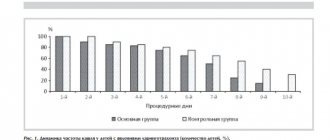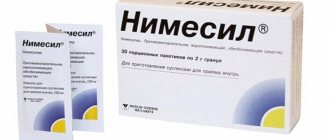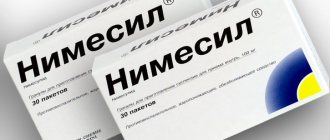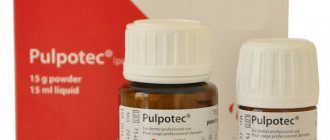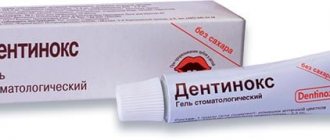Author of the article:
Soldatova Lyudmila Nikolaevna
Candidate of Medical Sciences, Professor of the Department of Clinical Dentistry of the St. Petersburg Medical and Social Institute, Chief Physician of the Alfa-Dent Dental Clinic, St. Petersburg
According to statistics, every second person on the planet has suffered from gum inflammation at least once. It is not surprising: the modern rhythm does not allow us to properly care for the oral cavity; bacteria accumulate between the teeth and begin to actively multiply, which leads to various pathologies.
One of the most popular remedies for gum inflammation is the well-known Miramistin. This powerful solution will quickly destroy harmful bacteria and return you to normal life. But how do you know when it’s time to start rinsing? How to carry out the procedure correctly? Let's figure it out together.
Pharmacological properties of the drug Miramistin
Pharmacodynamics. The action of miramistin is based on the direct hydrophobic interaction of the molecule with the lipids of the membranes of microorganisms, leading to their fragmentation and destruction. In this case, part of the miramistin molecule, plunging into the hydrophobic portion of the membrane, destroys the supra-membrane layer, loosens the membrane, increases its permeability to high-molecular substances, changes the enzymatic activity of the microbial cell, inhibiting enzyme systems, which leads to inhibition of the vital activity of microorganisms and their cytolysis. Unlike other antiseptics, Miramistin has a highly selective action against microorganisms, since it has virtually no effect on human cell membranes. This effect is associated with a different structure of human cell membranes (much longer lipid radicals, which sharply limit the possibility of hydrophobic interaction of miramistin with cells). Miramistin has a pronounced antimicrobial effect against gram-positive and gram-negative, aerobic and anaerobic, spore-forming and asporogenic bacteria in the form of monocultures and microbial associations, including hospital strains with multidrug resistance to antibiotics. It has a detrimental effect on pathogens of sexually transmitted diseases: gonococci, Treponema pallidum, Trichomonas, chlamydia, selectively on herpes viruses. Has an antifungal effect on ascomycetes of the genus Aspergillus and genus Penicillium , yeast ( Rhodotorula rubra, Torulopsis gabrata , etc.) and yeast-like ( Candida albicans, Candida tropicalis, Candida krusei , etc.) fungi, dermatophytes ( Trichophyton rubrum, Trichophyton mentagrophytes, Trichophyton verrucosum, Trichophyton schoenleini, Trichophyton violaceum, Epidermophyton Kaufman-Wolf, Epidermophyton floccosum, Microsporum gypseum, Microsporum canis, etc.), as well as other pathogenic fungi (for example Pityrosporum orbiculare ( Malassezia furfur )) in the form of monocultures and microbial associations, including fungal microflora with resistance to chemotherapy drugs. Under the influence of miramistin, the resistance of microorganisms to antibiotics decreases. Miramistin has an anti-inflammatory and immunoadjuvant effect, enhances local protective reactions, regenerative processes, activates nonspecific defense mechanisms due to modulation of the cellular and local humoral immune response. Pharmacokinetics. When applied topically, it is not absorbed through the skin and mucous membranes.
What does it work on?
Miramistin acts on many harmful bacteria:
- streptococci;
- staphylococci;
- E. coli;
- Klebsiella;
- pseudomonas;
- aspergillus;
- penicillin and yeast fungi.
In addition, it acts on chlamydia, Treponema pallidum, and gonorrhea pathogens.
There are so-called hospital infections that can be picked up in a hospital setting. Such infections are often resistant to multiple antibiotics. There have always been difficulties in treating them. But Miramistin is precisely capable of influencing such pathogens.
Miramistin treats burns of various origins, including sunburn. It also protects burn surfaces from bacteria. It may also reduce bacterial resistance to antibiotics.
Indications for use of the drug Miramistin
surgery, traumatology: prevention of suppuration and treatment of purulent wounds: treatment of purulent-inflammatory processes of the musculoskeletal system. Obstetrics - gynecology: prevention and treatment of suppuration of postpartum injuries, wounds of the perineum and vagina; postpartum infections; inflammatory diseases of the genital organs (vulvovaginitis, endometritis). Combustiology: treatment of superficial and deep burns of II–IIIA degrees, preparation of burn wounds for autodermoplasty. Dermatology, venereology: treatment of candidiasis of the skin and mucous membranes, mycoses of the feet and large folds; prevention of sexually transmitted diseases (syphilis, gonorrhea, genital herpes, genital candidiasis). Urology: complex treatment of acute and chronic urethritis and urethroprostatitis of specific (chlamydia, trichomoniasis, gonorrhea) and nonspecific nature. Dentistry: treatment of periodontitis, stomatitis, hygienic treatment of removable dentures. Otolaryngology: complex treatment of acute and chronic otitis, sinusitis, tonsillitis, laryngitis.
Price and analogues
How much does Miramistin ointment cost? From 80 rubles. The cost of the solution is from 200 rubles. The price may vary depending on whether there is a sprayer or not.
The medicine can be bought at a pharmacy without a prescription.
Analogues of the drug for children and adults according to pharmacological properties:
- Rotokan - about 40 rubles;
- Chlorhexidine – up to 20 rubles;
- Chlorophyllipt - up to 150 rubles;
- Furacilin – 70-80 rub.
Rotokan is similar in its action to Miramistin
Use of the drug Miramistin
Locally. Surgery, traumatology, combustiology. For preventive and therapeutic purposes, miramistin is used to irrigate the surface of wounds and burns, loosely pack wounds and fistula tracts, and fix gauze swabs moistened with an antiseptic. The treatment procedure is repeated 2–3 times a day for 3–5 days. The method of active drainage of wounds and cavities with a daily consumption of about 1 liter of the drug is highly effective. Obstetrics - gynecology . In order to prevent postpartum infection, 50 ml of the drug is used in the form of vaginal tampons with an exposure of 2 hours for 5 days in the form of vaginal irrigations before childbirth (5–7 days), during childbirth after each vaginal examination and in the postpartum period. When delivering by caesarean section, the vagina is treated immediately before the operation, during the operation - the uterine cavity and the incision on it, and in the postoperative period, tampons moistened with 50 ml of solution are inserted into the vagina with an exposure of 2 hours for 7 days. Treatment of inflammatory diseases of the female genital organs is carried out by intravaginal administration of tampons with the drug for 2 weeks, as well as administration of the drug by electrophoresis. Venereology . For the prevention of sexually transmitted diseases, Miramistin is effective if it is used no later than 2 hours after sexual intercourse. Using the nozzle, insert the contents of the bottle into the urethra of men (2–3 ml), women (1–2 ml), into the vagina (5–10 ml) and into the urethra (1–2 ml) for 2–3 minutes. The skin of the inner thighs, pubis, and genitals is treated. Urology. In the complex treatment of urethritis and ureoprostatitis by endourethral instillation of 2–3 ml of 0.01% miramistin solution 1–2 times a day, course - 10 days. The procedure is repeated every other day. Otorhinolaryngology . In the complex treatment of purulent sinusitis, during puncture the maxillary sinus is washed with a sufficient amount of antiseptic. In the treatment of tonsillitis and laryngitis, repeated gargling with a solution of the drug is carried out. Dentistry . Treatment of periodontitis by introducing turundas moistened with miramistin solution into periodontal pockets, followed by applications to the gums for 15 minutes. During exacerbations, rinsing periodontal pockets with Miramistin using a syringe and introducing turundas moistened with the drug into the abscess cavity are used. After vestibuloplasty and frenulectomy, Miramistin is used in the form of baths on an outpatient basis. Miramistin is used for medicinal treatment of carious cavities, tooth canals after pulp extraction, and hygienic treatment of removable dentures.
Why do you need to rinse your mouth after tooth extraction?
After the tooth extraction procedure, a hole with damaged blood vessels remains. A blood clot forms in it, protecting the wound from infection. New mucous membrane grows under it, and the periosteum heals. If the clot is accidentally removed or washed out, bleeding may resume. The wound will become vulnerable to various infections. For this reason, complications often develop. Therefore, oral care after tooth extraction should be extremely careful.
Rinsing is prescribed to prevent wound infection and the occurrence of purulent-septic complications. They promote rapid healing of the gums and reduce swelling that is possible after surgery. Only a doctor can tell you whether it is necessary and possible to rinse your mouth after tooth extraction. Trying to treat a wound on your own can be harmful.
Special instructions for the use of the drug Miramistin
The drug does not have a local irritant effect and does not have allergenic properties. Venereology. Urology. After treating the urethra, vagina, inner thighs, pubis and genitals with miramistin, it is not recommended to urinate for 2 hours. Use during pregnancy and lactation. Since drug resorption is almost completely absent, Miramistin can be used during pregnancy and lactation. The ability to influence the reaction rate when driving a vehicle or working with other mechanisms. During treatment with the drug, it is possible to drive vehicles and engage in other potentially hazardous activities that require increased concentration and speed of psychomotor reactions.
Features of use
Miramistin must be spat out after treatment of the oral cavity, but in case of accidental ingestion, there is no need to worry.
People who have been diagnosed with a catarrhal form of gastritis, provoked precisely by an imbalance of the positive microflora of the gastrointestinal tract, should use the solution more carefully.
This is interesting: What to do if a yellow coating appears on the tongue: why, how to decipher the body’s signal
During dental treatment of teeth, gums or oral mucosa, a burning sensation may occur - this is a normal reaction. You just have to remember that the drug should be used only for local treatment. Accordingly, if it is necessary to act exclusively on a small area of the gum, then it is better to use a tampon rather than completely rinse the oral cavity.
When performing retraction (putting a thread into the gum pocket), only cotton material is used. After removing it, you should not rinse your mouth with water.
Use by children and pregnant women
The age restrictions specified in the instructions are mainly aimed at the fact that children do not yet know how to rinse their mouths and therefore can swallow the product. If other means do not help and there is a need to use Miramistin for a small child, then you can use a spray or treat the affected areas with a piece of gauze soaked in the solution.
If the child has the skills to rinse the mouth, then you can give him 3-4 ml of the product, after diluting it with water in a ratio of 1:1.
According to the instructions, there are no contraindications for using an antiseptic during pregnancy or lactation. The drug does not penetrate into the blood, so it will not harm the fetus. But doctors recommend first testing for an allergic reaction. To do this, drop a small amount of solution onto the skin of the wrist, rub and wait 15-20 minutes. If there is no negative reaction (redness, blisters, rash), then you can rinse your mouth with Miramistin according to the instructions. This product should not be used as a douche during pregnancy.
Features of use for children
The neutral taste and light composition make it possible to use Miramistin for candidiasis even in children in the first years of life. The main problem is that children cannot rinse their mouths, so a special nozzle with a long spout can help parents. An adult opens the oral cavity with a small spoon and holds it in this position, while simultaneously quickly pressing on the lid.
During the procedure, it is necessary to avoid applying Mirimistin to the larynx and tonsils. This may cause a coughing fit or lead to cramping. If painful plaques and sores are found on the inner surface of the cheek, gums and under the tongue, a few drops of antiseptic are applied to a clean cotton swab. They wipe the inflamed areas with it, carefully blotting open wounds. Using a piece of gauze and medicine, you can remove the whitish film, slowing down the development of candida bacteria and improving the baby's condition.
General dentist recommendations
The oral cavity should be rinsed, holding each portion in the problem area for half a minute (frequency - 5-6 times a day). Do not use a hot solution - body temperature is considered optimal. It is forbidden to use hydrogen peroxide, strong alcoholic drinks, or a concentrated solution of potassium permanganate - this will not alleviate suffering, but will aggravate the situation by burning the mucous membrane.
Sign up for a consultation
It is important to remember that rinsing cannot cope with dental problems - they only help reduce discomfort and to some extent relieve the inflammatory process. A visit to the dental office will allow you to find out the cause of the pain and completely get rid of it.
Douching with an antiseptic
An antiseptic can also be used for douching. Is it worth doing this procedure before you visit a gynecologist? Definitely not. In this case, the doctor will not be able to conduct a full examination if you clean the vagina of bacteria.
In this case, making a correct diagnosis will be extremely difficult. For douching you will need a douche bulb, or an ordinary Esmarch mug. Rubber tubes or a syringe must be thoroughly disinfected with alcohol, and then rinsed with boiled water.
The tips of the Esmarch mug are usually boiled. You must be sure that the medical instruments are completely sterile.
This procedure must be carried out extremely carefully.
Recommendations from experts
If you find that your gums are bleeding, you should immediately visit a dentist. Only in this case can serious complications and constant relapses be avoided. The specialist will establish an accurate diagnosis and prescribe effective treatment.
Only experienced specialists take Cerekon in dentistry. Here you will be helped to get rid of bleeding gums quickly and painlessly. The clinic has the latest equipment for accurate diagnosis and high-quality treatment of any dental and periodontal diseases. We offer each patient comfortable treatment conditions and guarantee a positive result.
Remember that it is not always possible to cope with bleeding at home. Sometimes we are talking about more serious diagnoses that require urgent medical intervention. As soon as you encounter this problem, do not delay your visit to the doctor.


